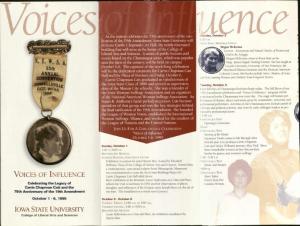This is the first in a series of blog posts featuring notable women of ISU. To kick off this series, I am beginning with an obvious choice – Carrie Chapman Catt. Catt is known for her work in the women’s suffrage movement and is so notable that a campus building was named after her (Catt Hall). [It’s worth noting that in 1998 there was a controversy about the naming of the building, known as the September 29th Movement (collection RS 22/3/3), and a review committee was formed in response (RS 22/1/8).]
Without further adieu, here is the lady of the hour.

Carrie Chapman Catt was born January 9, 1859, to Maria Clinton and Lucius Lane in Ripon, Wisconsin. Around 1865, the family moved to Charles City, Iowa. Catt then attended Iowa State College and graduated in 1880 at the top of her class.
During her time in Ames, she established military drills for women, became the first woman student to give an oration before a debating society, earned extra money as assistant to the librarian, and was a member of Pi Beta Phi.
Post-graduation, she became the high school principal in Mason City and then in 1883 the superintendent of Mason City Schools. While there, she met her first husband, Leo Chapman, editor of the Mason City Republican. They married in February 1885. After his death in 1886, she went to California and worked as a newspaper reporter before returning to Iowa to take on women’s suffrage.
Early on in her suffrage work, she ran into a classmate from Ames, George W. Catt. They were married in 1890. He supported his wife’s work both financially and personally until his death in October 1905.
Carrie Chapman Catt served as president of the National American Woman Suffrage Association from 1900-1904 and from 1915 until women’s right to vote was attained (1920). In addition, she formed the International Woman Suffrage Alliance and served as president of that organization for many years. When women won the right to vote, Catt encouraged the formation of the League of Women Voters.
Throughout her life, Catt received a great deal of recognition for her work, including many awards such as the Chi Omega (1941), the Pictorial Review Award (1931), and induction into the Iowa Women’s Hall of Fame. She died at her home in New Rochelle, New York in 1947.

More information and materials related to Carrie Chapman Catt can be found here in Special Collections and University Archives in the Carrie Chapman Catt Papers. We also have other women’s collections, including the Woman Suffrage Collection. In addition, see this webpage for resources available online. Have a look, and stop by sometime!







 Today, August 26th, marks the 90th anniversary of the 19th amendment becoming law, giving women in the United States the right to vote. What might Iowa State have had to do with women gaining the right to vote back in 1920? Carrie Chapman Catt graduated from Iowa State in 1880 at the top of her class. Catt worked diligently for woman’s suffrage both in the United States and internationally, and was the president of the National American Woman Suffrage Association (NAWSA) when the 19th amendment was passed. In fact, she was president of NAWSA for many years and came back to the presidency in 1915 to reorganize and strengthen the association. After the 19th amendment became law, she then helped organize the League of Women Voters.
Today, August 26th, marks the 90th anniversary of the 19th amendment becoming law, giving women in the United States the right to vote. What might Iowa State have had to do with women gaining the right to vote back in 1920? Carrie Chapman Catt graduated from Iowa State in 1880 at the top of her class. Catt worked diligently for woman’s suffrage both in the United States and internationally, and was the president of the National American Woman Suffrage Association (NAWSA) when the 19th amendment was passed. In fact, she was president of NAWSA for many years and came back to the presidency in 1915 to reorganize and strengthen the association. After the 19th amendment became law, she then helped organize the League of Women Voters.






